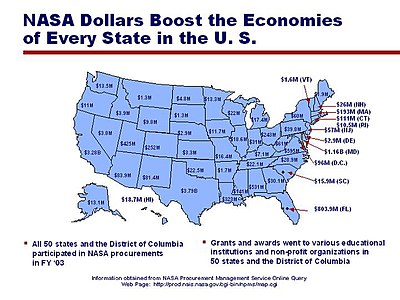Solvency
Increasing the NASA budget provides long term positive impact in multiple areas.
Economic impact of NASA funding
A November 1971 study of NASA released by the Midwest Research Institute of Kansas City, Missouri ("Technological Progress and Commercialization of Communications Satellites." In: "Economic Impact of Stimulated Technological Activity") concluded that “the $25 billion in 1958 dollars spent on civilian space R & D during the 1958-1969 period has returned $52 billion through 1971 -- and will continue to produce pay offs through 1987, at which time the total pay off will have been $181 billion. The discounted rate of return for this investment will have been 33 percent.”

A map from NASA's web site illustrating its economic impact on the U.S. states (as of
FY2003)
A 1992 article in the British science journal Nature reported:[9]
"The economic benefits of NASA's programs are greater than generally realized. The main beneficiaries (the American public) may not even realize the source of their good fortune. . ."
Other statistics on NASA's economic impact may be found in the 1976 Chase Econometrics Associates, Inc. reports ("The Economic Impact of NASA R&D Spending: Preliminary Executive Summary.", April 1975. Also: "Relative Impact of NASA Expenditure on the Economy.", March 18, 1975) and backed by the 1989 Chapman Research report, which examined 259 non-space applications of NASA technology during an eight year period (1976–1984) and found more than:
— $21.6 billion in sales and benefits;
— 352,000 (mostly skilled) jobs created or saved,and;
— $355 million in federal corporate income taxes
According to the "Nature" article, these 259 applications represent ". . .only 1% of an estimated 25,000 to 30,000 Space program spin-offs."
In 2002, the aerospace industry accounted for $95 billion of economic activity in the United States, including $23.5 billion in employee earnings dispersed among some 576,000 employees (source: Federal Aviation Administration, March 2004).